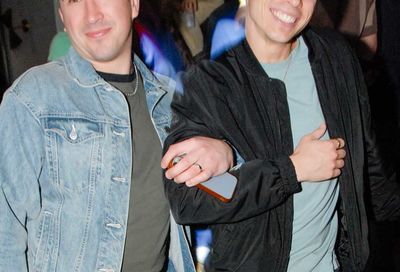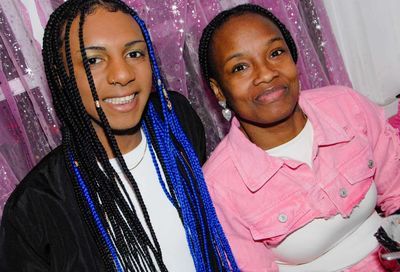Classic album revisited: Culture Club’s “Colour By Numbers”
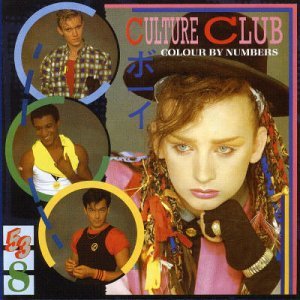 It couldn’t have been lost on Boy George, now 52, that as his latest solo album “This Is What I Do” hit stores this past October, it was almost exactly 30 years since the release of the album for which he’ll always be best-known: the ‘80s classic “Colour By Numbers.” Along with their debut, 1982’s “Kissing to Be Clever,” “Colour By Numbers” helped define the decade musically and culturally. “Colour By Numbers” is a superb pop record, well-produced and arranged and loaded with great songs. It stands today, 30 years later, as an essential artifact of its era, and it’s still a great listen.
It couldn’t have been lost on Boy George, now 52, that as his latest solo album “This Is What I Do” hit stores this past October, it was almost exactly 30 years since the release of the album for which he’ll always be best-known: the ‘80s classic “Colour By Numbers.” Along with their debut, 1982’s “Kissing to Be Clever,” “Colour By Numbers” helped define the decade musically and culturally. “Colour By Numbers” is a superb pop record, well-produced and arranged and loaded with great songs. It stands today, 30 years later, as an essential artifact of its era, and it’s still a great listen.
The timing could not have been more perfect for Culture Club. It was October, 1983, just as MTV was reaching its period of maximum influence in music and pop culture. Culture Club had already enjoyed an amazing year by the time “Colour By Numbers” hit the shelves. Their first album, “Kissing to Be Clever,” had made them a media sensation on the strength of their smash single “Do You Really Want To Hurt Me?”, a reggae-tinged classic which rocketed up the charts and held at #2 in the US during the Spring of 1983 (unable to break through Michael Jackson’s 7-week stranglehold on the top spot with “Billie Jean”). MTV got behind the band almost immediately, and in an age when dress and even makeup was becoming more and more flamboyant, Boy George’s look didn’t deter radio from playing the band’s music. That in itself is a testament to the quality and mass appeal of the songs. Two more Top 10 hits quickly followed — the old-school R&B/pop ballad “Time (Clock of the Heart”), which hit #2 in the spring of ’83, and the jubilant calypso-flavored “I’ll Tumble 4 Ya,” a joyous, infectious number that was again featured prominently on MTV, which hit #9 during that summer.
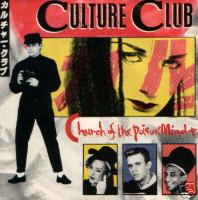 Hardly any time at all passed before the first single from their next album was already saturating the MTV airwaves. This was an era when artists would frequently release an album ever year, and sometimes the last single from the prior album would be immediately followed by the first single of the next album. That’s exactly what happened with “Church of the Poison Mind,” released in October, 1983, barely three months after “I’ll Tumble 4 Ya” was issued as a single. In retrospect, “Church of the Poison Mind” may have been a slight misstep. Driven by a strong Motown-influenced rhythm section, “Church of the Poison Mind” is an upbeat, hard-driving R&B pop song with a prominent harmonica riff and a funky counter-vocal by Helen Terry, a powerhouse vocalist who would become well-known for her contributions to Culture Club’s music. “Church of the Poison Mind” was released nearly simultaneously with “Colour By Numbers,” and would reach #10 in the US – – a top 10 hit, sure, but not exactly what Epic Records had in mind for the lead single to an album for which the stakes were high given the success of its predecessor. Perhaps the inscrutable subject matter limited its appeal. In addition, the high-pitched wailing harmonica riff is way too high in the mix, and the lovely keyboard counter-melody and the popping bass-line are both way too low.
Hardly any time at all passed before the first single from their next album was already saturating the MTV airwaves. This was an era when artists would frequently release an album ever year, and sometimes the last single from the prior album would be immediately followed by the first single of the next album. That’s exactly what happened with “Church of the Poison Mind,” released in October, 1983, barely three months after “I’ll Tumble 4 Ya” was issued as a single. In retrospect, “Church of the Poison Mind” may have been a slight misstep. Driven by a strong Motown-influenced rhythm section, “Church of the Poison Mind” is an upbeat, hard-driving R&B pop song with a prominent harmonica riff and a funky counter-vocal by Helen Terry, a powerhouse vocalist who would become well-known for her contributions to Culture Club’s music. “Church of the Poison Mind” was released nearly simultaneously with “Colour By Numbers,” and would reach #10 in the US – – a top 10 hit, sure, but not exactly what Epic Records had in mind for the lead single to an album for which the stakes were high given the success of its predecessor. Perhaps the inscrutable subject matter limited its appeal. In addition, the high-pitched wailing harmonica riff is way too high in the mix, and the lovely keyboard counter-melody and the popping bass-line are both way too low.
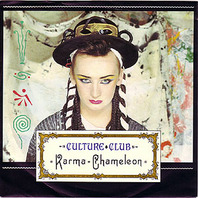 Still, it was a hit, and the second single from “Colour By Numbers” would end up far more successful, pushing the album to its peak of #2 in the US. Given the somewhat lackluster performance of the first single, and the fact that it was already rocketing up the UK charts, Epic Records rush-released “Karma Chameleon” a bare month after “Church of the Poison Mind.” “Karma Chameleon” became Culture Club’s only #1 single in America, spending three weeks at the top in February, 1984. “Karma Chameleon” became the band’s signature song, and one of those essential classics that helps define pop music in the ‘80s. Featuring a colorful video with elaborate costumes set in the 1800’s on a riverboat, the bouncy, infectious sing-along marked the peak of Culture Club’s success. It’s a cunning single, brilliantly produced by Steve Levine with a carefully layered vocal arrangement, effortless interplay between vocal, harmonica, and guitar, and an overall vibe of joy.
Still, it was a hit, and the second single from “Colour By Numbers” would end up far more successful, pushing the album to its peak of #2 in the US. Given the somewhat lackluster performance of the first single, and the fact that it was already rocketing up the UK charts, Epic Records rush-released “Karma Chameleon” a bare month after “Church of the Poison Mind.” “Karma Chameleon” became Culture Club’s only #1 single in America, spending three weeks at the top in February, 1984. “Karma Chameleon” became the band’s signature song, and one of those essential classics that helps define pop music in the ‘80s. Featuring a colorful video with elaborate costumes set in the 1800’s on a riverboat, the bouncy, infectious sing-along marked the peak of Culture Club’s success. It’s a cunning single, brilliantly produced by Steve Levine with a carefully layered vocal arrangement, effortless interplay between vocal, harmonica, and guitar, and an overall vibe of joy.
Interestingly, Boy George’s homosexuality didn’t dampen the band’s success, particularly with this single. It was the ‘80s, and flamboyance had become more and more common. There were those who clung to the notion that Boy George wasn’t gay at all. There were rumors that he and Helen Terry were an item. The public at large seemed willfully blind to the issue, and George himself played it coy. During the entire album “Colour by Numbers,” never once is the pronoun “He” or “She” used in any of the songs that are obviously dealing with a relationship. How would a song like “Karma Chameleon” have fared if Boy George had been open with his homosexuality at the time? An interesting question to which we’ll obviously never know the answer, but remember, this was three decades ago. No gay marriage, no Lady Gaga proclaiming in pop anthems you’re “Born this Way,” no “Glee” bringing gay relationships between young people into the mainstream and into houses all over the country. It was a different world back then… and yet somehow with Boy George there was no great uproar or backlash (there was some controversy over his androgynous look, sure, but not enough to prevent their singles from scaling the charts). George himself played coy when the question came up in interviews, never denying he was gay nor admitting it, and he became quite skillful in deflecting the issue.
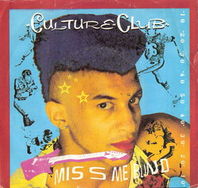 For the follow-up to “Karma Chameleon,” different territories got different tracks. In the UK and most of the rest of the world, it was the haunting, soulful ballad “Victims,” the album’s closer, and one of George’s finest vocal deliveries. A dramatic piano-based piece with beautiful string and vocal arrangements, “Victims” is one of the band’s strongest recordings. “Victims” would reach #3 in the UK and become a Top 10 hit throughout Europe, but despite that Epic Records never saw fit to release it as a single in the US, evidently thinking that the poignant ballad wouldn’t resonate with American listeners. America instead got the upbeat pop-rocker “Miss Me Blind,” released on Valentine’s Day, 1984. Featuring a video with a Japanese motif that received heavy MTV support, “Miss Me Blind” shot into the Billboard Hot 100 all the way up at #40 as its debut position on its way to a peak of #5. It would prove to be the band’s final Top 10 American hit.
For the follow-up to “Karma Chameleon,” different territories got different tracks. In the UK and most of the rest of the world, it was the haunting, soulful ballad “Victims,” the album’s closer, and one of George’s finest vocal deliveries. A dramatic piano-based piece with beautiful string and vocal arrangements, “Victims” is one of the band’s strongest recordings. “Victims” would reach #3 in the UK and become a Top 10 hit throughout Europe, but despite that Epic Records never saw fit to release it as a single in the US, evidently thinking that the poignant ballad wouldn’t resonate with American listeners. America instead got the upbeat pop-rocker “Miss Me Blind,” released on Valentine’s Day, 1984. Featuring a video with a Japanese motif that received heavy MTV support, “Miss Me Blind” shot into the Billboard Hot 100 all the way up at #40 as its debut position on its way to a peak of #5. It would prove to be the band’s final Top 10 American hit.
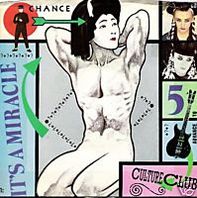 The next single extracted from “Colour By Numbers” was the tropical-flavored “It’s a Miracle,” built around a bouncy keyboard riff designed to mimic steel drums and contributed by session musician Phil Pickett (he would receive a co-writing credit for the track). “It’s a Miracle” fell just short of the Top 10 in America, landing at #13 in the spring of ’84. It was the first sign that Culture Club mania was starting to wane in America. No further singles were issued from “Colour By Numbers” (a promotional single for the upbeat, horn-driven track “Mister Man” was issued, but ultimately it was shelved. The song is more topical than the typical Culture Club track, dealing with gun violence, and it would have been interesting to see how it would have fared as a single).
The next single extracted from “Colour By Numbers” was the tropical-flavored “It’s a Miracle,” built around a bouncy keyboard riff designed to mimic steel drums and contributed by session musician Phil Pickett (he would receive a co-writing credit for the track). “It’s a Miracle” fell just short of the Top 10 in America, landing at #13 in the spring of ’84. It was the first sign that Culture Club mania was starting to wane in America. No further singles were issued from “Colour By Numbers” (a promotional single for the upbeat, horn-driven track “Mister Man” was issued, but ultimately it was shelved. The song is more topical than the typical Culture Club track, dealing with gun violence, and it would have been interesting to see how it would have fared as a single).
Although the singles were obviously the main focus on “Colour By Numbers,” the album tracks were strong too. In fact, one of the best moments on the album is the emotional ballad “That’s The Way (I’m Only Trying to Help You),” which ends Side One. It’s a stripped-down piano ballad and essentially a duet between George and Helen Terry. George is at his most soulful, and Terry shines with her emotional, increasingly dramatic repetitions of “I’m only trying to help you” during the song’s conclusion. It’s a brief track, but it leaves a lasting impression. “That’s the Way” is another example of Culture Club’s music and talent sometimes being overlooked by their outlandish image. The band wrote and performed all of the tracks on “Colour By Numbers” themselves — with limited contributions by outside musicians (like the occasional saxophone, some backing vocals and, most significantly, Judd Lander’s prominent harmonica).
“Black Money” is another strong track, a downbeat ballad with an elaborate arrangement and another nice vocal by Terry. “Changing Everyday” continues the band’s exploration of various styles from around the world, using a Bossa nova beat during the verses and built around a strong piano riff. “Stormkeeper,” tucked away as the second-to-last track on the album, is the perhaps the album’s weakest moment. It’s a rather pedestrian mid-tempo number that might have worked better as a b-side, especially considering the beautiful ballad “Colour By Numbers” was kept off the album despite being the title track (it would appear as the b-side on the “Victims” single and would ultimately be included on the deluxe reissue of “Colour By Numbers” along with several other interesting b-sides and bonus tracks).
“Colour By Numbers” is a landmark album both musically and culturally, but Culture Club’s chart success would prove short-lived. Their next album “Waking Up With the House on Fire,” released in the fall of ’84, and its first single “The War Song” would prove commercial disappointments, and their final album (until a reunion album in the late ‘90s), “From Luxury to Heartache” was a critical and commercial flop (although it did score a Top 20 hit in the US with “Move Away”). By then Boy George had become so addled by drugs that he was reportedly barely able to stand up in the studio to deliver a vocal.
Culture Club “mania” was surprisingly brief, especially in the US, given their oversized impact on ‘80s music and culture — “Do You Really Want to Hurt Me?” entered the US charts in December, 1982, and “It’s A Miracle” hit in April, 1984 — less than a year and a half before a substantial commercial slide. But during those 17 months, Culture Club was as big as any band in America. Culture Club’s success can certainly be laid in large part at the door of MTV. Without their promotion of the band’s colorful videos, they’d never have broken through. But, more importantly, the songs were fantastic — highly imaginative, melodic, infectious and fun. Culture Club was a talented group of musicians and they had a chemistry, flamboyance and style that was like nobody else — but with Culture Club, it was never a case of style over substance. They had both. “Kissing to Be Clever” is a fine debut, and “Colour By Numbers” stands up thirty years after its release as one of the great pop albums of the decade. It has aged well, and it’s hard not to smile when that opening guitar run and harmonica riff of “Karma Chameleon” start up on the radio. Nowadays they are still well-loved, with their hits still getting frequent airplay and appearing on ‘80s compilations with regularity. Meanwhile, Boy George continues his solo career, and his excellent new album “This Is What I Do” is well-worth picking up. His voice has deepened and grown more husky than it was thirty years ago, but he is still one of the most expressive voices in pop music.
Previous articles in the “Classic Albums: Revisited” series:
Eurythmics: Sweet Dreams (Are made of This) – single
Support Metro Weekly’s Journalism
These are challenging times for news organizations. And yet it’s crucial we stay active and provide vital resources and information to both our local readers and the world. So won’t you please take a moment and consider supporting Metro Weekly with a membership? For as little as $5 a month, you can help ensure Metro Weekly magazine and MetroWeekly.com remain free, viable resources as we provide the best, most diverse, culturally-resonant LGBTQ coverage in both the D.C. region and around the world. Memberships come with exclusive perks and discounts, your own personal digital delivery of each week’s magazine (and an archive), access to our Member's Lounge when it launches this fall, and exclusive members-only items like Metro Weekly Membership Mugs and Tote Bags! Check out all our membership levels here and please join us today!




















